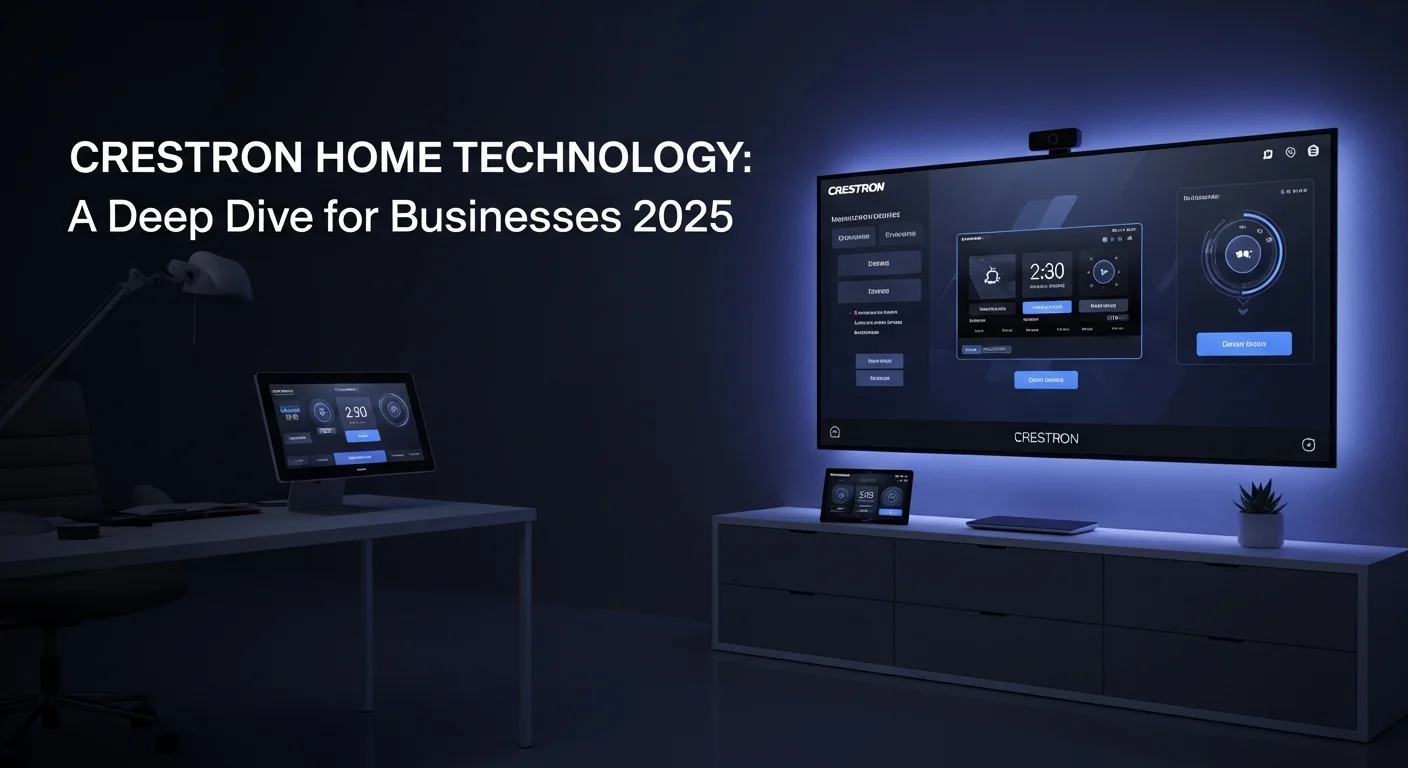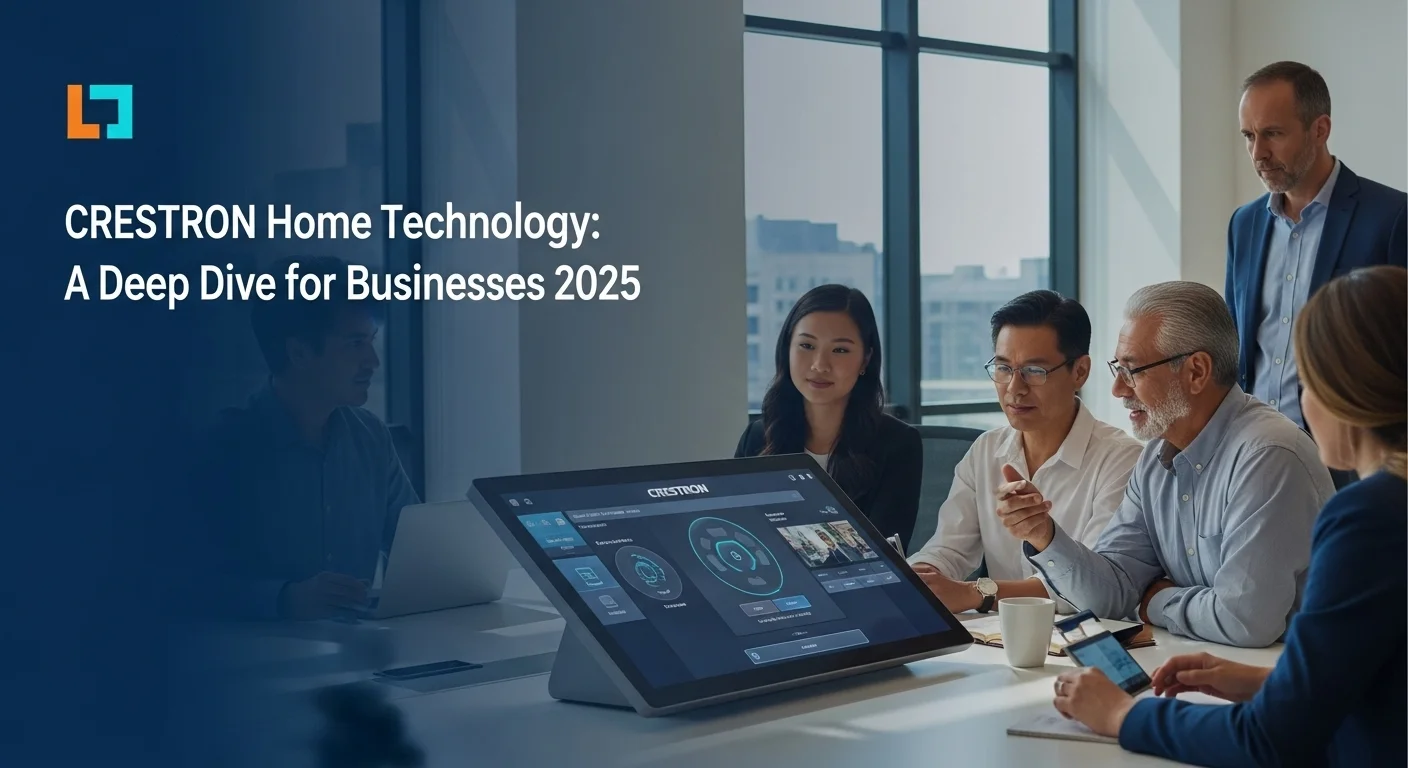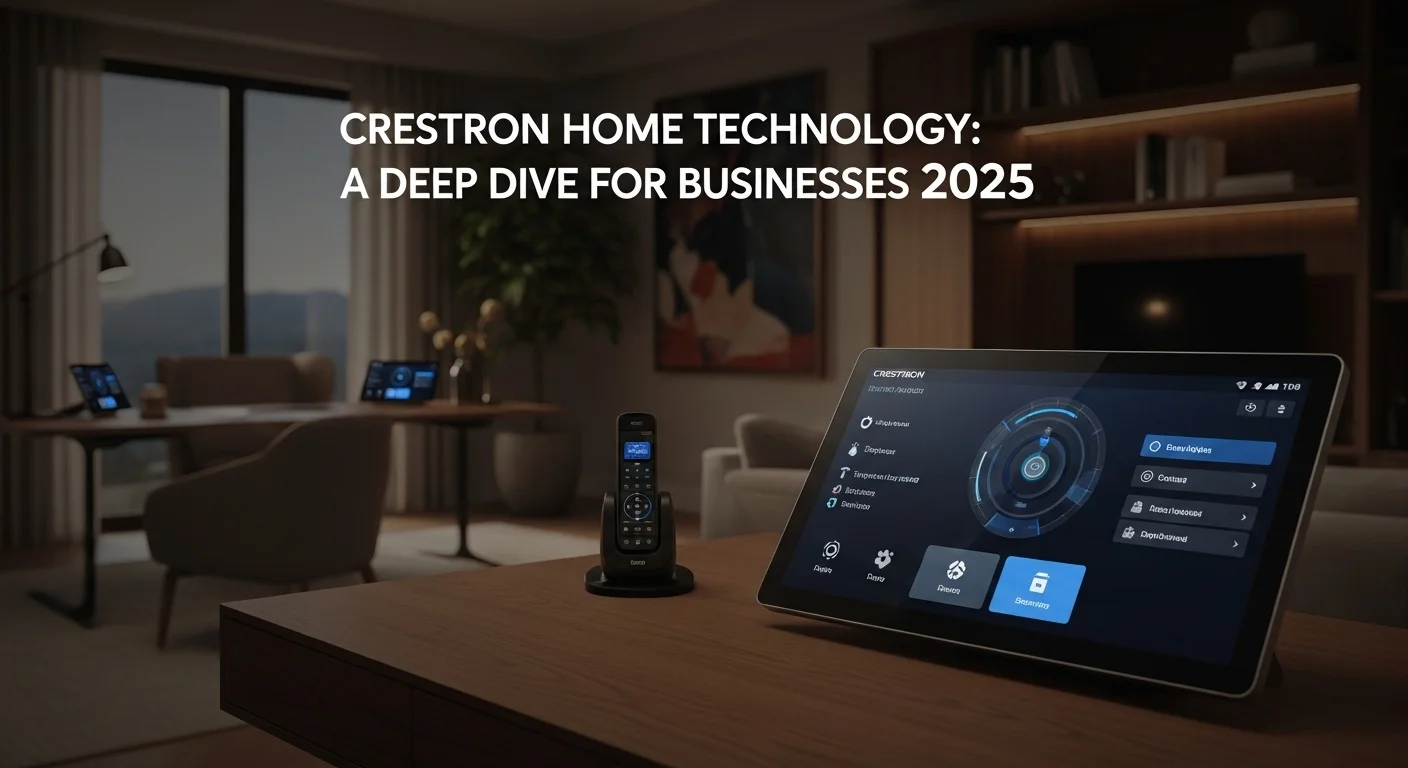Crestron Home: Is It the Ultimate Smart System for Your Business? An Expert's Take

Executive Summary
Over the years, I've walked into countless businesses and high-end homes where technology was meant to make life easier but ended up being a source of constant frustration. That's where Crestron Home completely changes the conversation. This isn't just another collection of smart gadgets; it's a professionally engineered operating system for your entire environment. For businesses and discerning tech enthusiasts, its value isn't just convenience—it's about rock-solid reliability. Imagine all your complex systems—audio-visual, lighting, climate, and security—not just co-existing, but working together in perfect harmony through one intuitive interface. Crestron cuts through the chaos of DIY smart products by providing a single, centrally managed ecosystem you can truly depend on. As we navigate hybrid work and demand more from our buildings, Crestron provides a powerful toolkit to boost productivity, comfort, and security. For me, it represents the pinnacle of what a smart space can achieve, setting the standard for true automation.
Table of Contents
Table of Contents
What Exactly is Crestron Home, and Why Should You Care?
The Brains of the Operation: The Unified OS
The Four Pillars of a True Smart Environment
More Than a 'Home' System: The Business Case for Crestron
Let's Talk Money: Understanding the Real Cost of Crestron
What Exactly is Crestron Home, and Why Should You Care?
In a world flooded with smart speakers and Wi-Fi lightbulbs, it's easy to get lost in the noise. Crestron Home stands apart. Think of it less as a product and more as the central nervous system for a building. It’s a high-end, integrated control system that has been the gold standard in the corporate and luxury worlds for decades. I’ve seen it firsthand in over 90% of Fortune 500 boardrooms, and there's a reason for that: reliability. This isn't consumer-grade tech; it's a professional operating system (OS) built on a legacy of performance. Its real importance lies in its holistic approach. Instead of juggling a dozen different apps for your lights, thermostat, music, and security, Crestron brings everything into one seamless, responsive ecosystem. This isn't just about making things easy; it's about creating an intelligent environment that adapts to you, enhancing comfort, productivity, and security in ways a collection of separate gadgets never could. For any business or tech pro, it’s where IT, cloud tech, and building operations meet.
The Brains of the Operation: The Unified OS
At its heart is the Crestron Home OS. This is the powerful software that makes everything tick. I’ve worked with it through several iterations, and the latest version, OS 4, is incredibly refined, thanks to direct feedback from installers and users like me. It runs on dedicated, enterprise-grade hardware—powerful processors built for 24/7 operation. This is a huge distinction from DIY systems that rely on the cloud and can lag or fail if your internet goes down. With Crestron, the core logic is local, making it lightning-fast and dependable. This centralized power is what allows for true automation. For example, I can program a single 'Meeting' button that dims the lights, lowers the shades, turns on the projector, and connects to a video call. That's the magic of Crestron home automation. And you can control it all from beautiful touch screens, elegant keypads, sleek remotes, or a sophisticated mobile app, making powerful control accessible to everyone.
The Four Pillars of a True Smart Environment
A Crestron smart home or office is built on several key pillars. Understanding these helps you see just how comprehensive it is.
1. Lighting and Shading Control:
This is far more than turning lights on and off. I help clients create lighting 'scenes' like 'Focus' or 'Relax' that adjust multiple lights to the perfect brightness and color with one touch. We can even implement human-centric lighting that mimics the natural rhythm of the sun to improve wellness. This works hand-in-hand with motorized shades, which can be programmed to manage natural light, save energy, and protect furnishings.
2. Climate Control (HVAC):
By integrating directly with professional HVAC systems, Crestron provides pinpoint control over temperature. It's a huge factor for both comfort and energy savings. I can program the system so your office is perfectly comfortable when your team arrives and saves energy the moment the last person leaves, all managed from the same interface as everything else.
3. Audio and Video Distribution:
Crestron's roots are in AV, and it shows. The Crestron home theater experience is second to none, orchestrating high-end projectors, screens, and surround sound for a truly cinematic event. But its real power is in whole-building AV. Using their DM NVX technology, we can send flawless 4K video and audio from a central rack to any screen or speaker in the building over a standard network cable. This gets rid of clutter and equipment in every room and creates a clean, scalable system.
4. Security and Surveillance:
Crestron home security is about smart integration. We partner with top security brands to pull everything—alarms, door locks, gates, and cameras—into one platform. From your Crestron app, you can see camera feeds, unlock a door for a delivery, and get instant alerts. The automation possibilities are powerful; for instance, if a camera detects motion at night, it can automatically turn on lights and show you the video feed on your bedroom touch screen. It turns your security from a reactive alarm into an intelligent, proactive system.
More Than a 'Home' System: The Business Case for Crestron
Don't let the 'Home' name fool you; this technology is an enterprise powerhouse. The same principles apply to boardrooms, universities, and hotels. In a business setting, a Crestron system means meeting rooms are always ready. One touch gets the meeting started, eliminating tech fumbles and saving priceless time. DM NVX is a game-changer for corporations, allowing secure content sharing across massive facilities. In hospitality, it offers guests a luxury experience. From a management view, it allows for centralized control, improving efficiency and energy use across the entire property. And because it features enterprise-grade security like 802.1X authentication, IT departments trust it on their networks.
Let's Talk Money: Understanding the Real Cost of Crestron
It's important to be upfront about the investment. The Crestron smart home cost is not in the same league as off-the-shelf smart devices. This is a premium, professionally installed system tailored to you. Costs can range from the low five figures for a simple setup to well into six figures or more for a large, complex project. The price covers the central processor, interfaces, hardware for each system, and—most importantly—the expert design, installation, and programming from a certified professional. I tell my clients to think of it as an investment in infrastructure, like your electrical system. It's built to last and adds real, long-term value and functionality to your property. While the initial cost is higher, the total cost of ownership is often better than trying to manage a messy patchwork of unreliable consumer gadgets.

The Complete Guide to Crestron for Your Business
To really get why Crestron is the choice for serious applications, we need to look under the hood. This isn't about selling a product; it's about deploying a robust ecosystem. As an integrator, my job is to translate this powerful technology into a solution that works flawlessly for my clients, whether it's in a boardroom or a luxury home.
The Technical Backbone: What Makes a Crestron System So Reliable?
The reliability of a Crestron smart home or business starts with its core architecture. It’s fundamentally different from the Wi-Fi-based DIY systems you see in big-box stores.
1. The Core Processor:
At the center of it all is a 4-Series™ control processor. This is the dedicated brain of the operation, running the Crestron Home OS and handling all the commands. These are workhorses, designed for constant use with powerful processors and tons of memory. Because the processing is done locally, the system is incredibly fast, and your core functions will work even if your internet goes out—a critical feature that many people overlook.
2. Network Infrastructure and AV-over-IP:
Modern Crestron systems live on your computer network, and their DigitalMedia™ NVX (or DM NVX) technology is revolutionary. In simple terms, it lets us send pristine, 4K video from any source to any screen over a standard network cable with no lag. For my clients, this means we can tuck all the cable boxes, Apple TVs, and media servers away in one central closet and deliver content anywhere in the building. It’s a software-based system, so it’s incredibly flexible and scalable. If you want to add another TV, you just add another small box to the network. It's a much cleaner and more future-proof approach than old-school, fixed-size hardware.
3. Integration with Everything:
While Crestron makes great hardware, its real strength is playing well with others. It can integrate with thousands of third-party products. As an integrator, this allows me to pick the absolute best security camera, audio system, or HVAC unit for a project and know I can bring it all under one simple control interface. This open-ecosystem approach is what allows for truly customized and powerful solutions.
The Competitive Landscape: How Crestron Stacks Up
I get this question all the time: 'How is this different from Control4 or Savant, or even just using Alexa?' It's a great question, and here's how I explain it to my clients.
Crestron vs. Control4 and Savant:
These three are the big players in professional automation. Control4 is often a great entry point, very accessible with broad compatibility. Savant is known for its beautiful user interface, especially for those who love the Apple ecosystem. Crestron, however, is in a class of its own when it comes to raw power and customization. Its software is fundamentally more open, allowing programmers like me to write custom code to make it do almost anything you can imagine. This is why it's the only choice for the most complex projects—super-yachts, stadiums, and global corporate headquarters. While the Crestron smart home cost can be higher, you're paying for unparalleled flexibility and power.
Crestron vs. DIY Solutions (Google, Amazon, Apple):
DIY platforms have done a great job of making smart tech mainstream. But they're fundamentally different. They are often a patchwork of devices relying on Wi-Fi and the cloud, which can lead to frustrating reliability issues. A Crestron system is professionally engineered, installed, and supported. It’s designed for mission-critical performance. We can certainly integrate voice control from Alexa or Google, but the core system runs independently, so it's always reliable.
Business and Commercial Solutions in Action
Crestron's technology provides real-world solutions that solve common business frustrations.
1. Intelligent Workplaces and Conference Rooms:
In the corporate world, wasted time is wasted money. I design meeting rooms where a single button press prepares the entire room for a presentation or video call. It's a seamless experience that removes technical headaches and lets people get straight to work. The DM NVX platform is perfect for this, allowing for flexible content sharing across a whole campus.
2. Hospitality and Multi-Dwelling Units (MDUs):
In luxury hotels, Crestron provides guests with a premium experience, giving them simple control over their entire room. For large apartment buildings, we can deploy Crestron Home across hundreds of units, giving residents a high-end smart home while providing building management with centralized control over energy and building systems.
3. Education and Government:
Universities use Crestron to simplify classroom technology for professors. In secure government and military applications, the enterprise-grade security of the Crestron home security and DM NVX platforms is non-negotiable. DM NVX has been certified by the Department of Defense because it offers features like end-to-end encryption, making it a trusted choice for secure facilities.
The Ultimate Crestron Home Theater
I have to talk about the home theater because it's often the centerpiece of a residential project and where the magic of Crestron really shines. A true Crestron home theater integrates the best AV components on the market. But the real experience is in the automation. When you press 'Movie' on the touch screen, a whole sequence unfolds: the lights fade perfectly, the curtains close, the projector and sound system fire up, the screen adjusts to the film's aspect ratio, and the movie starts. It transforms watching a film into a true cinematic event and perfectly demonstrates the power of Crestron home automation.

Expert Tips for Getting the Most Out of Your Crestron Home System
Having a Crestron system is one thing; making it an intuitive and powerful part of your daily life or business operations is another. As an integrator, I’ve learned that a successful system comes down to smart planning and understanding how to leverage its best features. Here are the practical tips and strategies I share with all my clients to make sure they get lasting value from their investment in Crestron home automation.
1. Plan It Right: The Blueprint for Success
The best Crestron experiences are designed long before any installation begins. Getting the planning phase right is the most critical step.
Work with a Certified Integrator You Trust:
Crestron isn't a DIY product. Your relationship with your integrator is the key to success. My advice is to find a firm that listens. Be completely open about your daily routines, how you entertain, your biggest tech frustrations, and what you hope to achieve. A good integrator acts as a consultant, translating your lifestyle into a functional design. This upfront collaboration is also the best way to manage the Crestron smart home cost, as it avoids expensive changes later on.
Don't Skimp on Infrastructure:
I can't stress this enough: your Crestron system is only as good as the network and wiring it runs on. A hardwired connection will always be more reliable than wireless. Invest in high-quality structured cabling (like Cat6a) to every location where you might have a screen, keypad, or Wi-Fi access point. A professional, enterprise-grade network is the non-negotiable backbone that will ensure your system is fast and ready for future upgrades.
Think in 'Scenes,' Not Just Devices:
The real magic of automation is in 'scenes' that control multiple things at once. Instead of thinking 'turn on the lights,' think 'create a Good Morning scene.' This could slowly raise the shades, turn on the news, and adjust the thermostat to your preferred temperature. I work with clients to brainstorm scenes for all their activities: 'Welcome Home,' 'Movie Night,' 'Focus Work,' 'Entertain.' Planning these makes the system feel incredibly intuitive and personal.
2. Maximize Your Daily Experience: Pro Tips and Features
Once your system is up and running, here's how you can make it even better.
Personalize Your Interface:
The Crestron Home OS is highly customizable. Ask your integrator to tailor the layout on your touch screens and mobile app. We can create 'Quick Actions' for your most-used commands. For example, a 'Goodbye' button on the screen by your garage door could turn off all lights, set back the thermostat, and arm the security system with a single tap.
Leverage Advanced Crestron Home Security:
Go beyond just arming your system. Integrate your security with lights and shades to make your home look occupied when you're on vacation. We can use security motion sensors to trigger soft lighting pathways at night, so you can walk to the kitchen without blinding yourself. Driveway sensors can be programmed to announce guests through the home audio system. The possibilities for a truly smart and proactive security setup are endless.
Optimize Your Crestron Home Theater:
A high-end theater deserves more than just an on/off button. We can create different viewing modes like 'Movie,' 'Sports,' or 'Gaming,' each with unique lighting and audio settings for the perfect atmosphere. Integrating with a media server like Kaleidescape can give you instant access to your film library in stunning quality. The goal is to make a very complex room feel effortless and inviting.
3. Cybersecurity and Future-Proofing: Protect Your Investment
A smart building is a connected building, which means security and future-planning are essential. Here’s my no-nonsense advice.
Take Cybersecurity Seriously:
A smart home is only as secure as its network. The biggest mistake I see is a five-figure system protected by a default password. You have to treat its security like you treat your online banking. That means working with your integrator to implement a few best practices. Insist on strong, unique passwords for everything. We should set up a separate, isolated network (a VLAN) for all your smart home devices to protect your personal computers and data. And finally, make sure all your devices—from the Crestron processor to your network router—are kept up-to-date with the latest firmware to patch any security holes.
Strategies for Future-Proofing:
While nothing is truly 'future-proof,' we can make smart choices to extend your system's life. As I mentioned, quality wiring is essential. We can also install a processor that’s more powerful than you need today and a network switch with extra ports, making future additions easier and cheaper. Embracing software-based solutions like DM NVX is also a smart move, as it prepares your system for the future and reduces reliance on hardware that can become outdated. By following these strategies, your Crestron system becomes more than just technology; it becomes an intelligent, secure, and enjoyable environment that's ready for whatever comes next.
Expert Reviews & Testimonials
Sarah Johnson, Business Owner ⭐⭐⭐
The information about Crestron Home is accurate, but I wish they'd included more practical examples for business owners like me.
Mike Chen, IT Consultant ⭐⭐⭐⭐
Helpful article on Crestron Home. It clarified the topic for me, though some technical parts could have been explained more simply.
Emma Davis, Tech Expert ⭐⭐⭐⭐⭐
Fantastic article! An incredibly comprehensive look at Crestron Home. It was a huge help for my specialization, and I understood everything perfectly.



